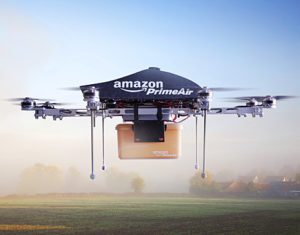
“The proposal to privatize air traffic management comes as the FAA and NASA are studying how drones will fit safely into the national airspace. NASA has been working with the FAA to test and research a new system, with the goal of finalizing the project by 2019,” writes April Glaser of Recode. “But if Trump follows through with privatizing air traffic control, a solution for national drone tracking might come even sooner.”
“Creating a way for drones to safely integrate into the national airspace is one of the biggest linchpins holding up the future of U.S. drone regulation and drone delivery more broadly, which has major implications for companies like Alphabet and Amazon, as well as traditional shipping companies like UPS that are readying for drone delivery.”
The article argues that taking drone integration out from under the FAA framework might make it more likely that an independent ATC company will choose to buy or contract a solution rather than attempt to build one from scratch. Additionally, separating integration from FAA processes should, in theory, speed things up. The idea makes sense, and it certainly has appeal to the drone industry.
But when it comes to large government infrastructure projects, speed is always relative. Drone analyst and industry expert Colin Snow doesn’t see drone integration or drone delivery coming anytime soon. Snow has written previously that drone integration has become an overly complex issue: one that looks increasingly difficult to address as the scope broadens. The President’s announcement won’t do much to change that immediately.
“I don’t think privatizing air traffic control (ATC) would necessarily expedite drone delivery in the U.S.,” says Snow. “There are two issues here: who runs ATC and who makes the regulations for beyond visual line of sight (BVLOS) operations. Under any scenario the FAA is the regulator. For BVLOS operations to occur a Federal Aviation Regulation (FAR) would need to be in place. Getting that rule in place starts a notice of proposed rulemaking (NPRM). An NPRM is a public notice issued by law when one of the independent agencies of the United States government wishes to add, remove, or change a rule or regulation as part of the rulemaking process…. If NASA’s UTM recommendations are released in 2019 it may be many months before those recommendations get incorporated into an FAA NPRM and another year or so before they become a FAR.”
“Many months” could be understating the case, given the FAA’s track record on issuing the Part 107 Small UAS Rule. Additionally, Snow remarks, a private company might want to see clearer evidence of demand than the current research provides before investing time and money in the project.
“Under a scenario of privatized ATC it still would be up to the company that runs it to determine what additional infrastructure would be needed for widespread BVLOS drone operations,” Snow points out. “That firm would assess the potential revenue, costs, and return on investment (ROI). That’s not something the government does, but it is what every company does. That said, it looks to me to be a long way off because I don’t think the potential revenues from drone delivery alone would enough to support additional infrastructure.”
Whether or not Congress decides to privatize the Air Traffic Control, when it comes to drone integration there is no quick fix in sight – and no obvious immediate path to widespread drone delivery. While the drone industry is growing quickly, applications like drone delivery may have to grow in tandem with integration and regulations for some time: a slower process, but one that may give an occasionally doubtful public time to get used to the idea.
Miriam McNabb is the Editor-in-Chief of DRONELIFE and CEO of JobForDrones, a professional drone services marketplace, and a fascinated observer of the emerging drone industry and the regulatory environment for drones. Miriam has penned over 3,000 articles focused on the commercial drone space and is an international speaker and recognized figure in the industry. Miriam has a degree from the University of Chicago and over 20 years of experience in high tech sales and marketing for new technologies.
For drone industry consulting or writing, Email Miriam.
TWITTER:@spaldingbarker
Subscribe to DroneLife here.